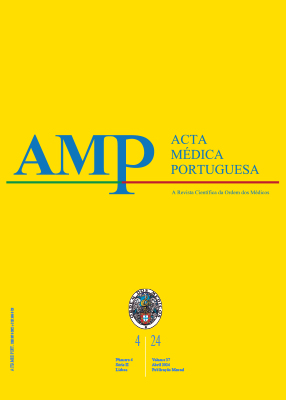Scalp Eschar and Neck Lymphadenopathy Associated with Rickettsial Infection After a Tick Bite: A Case Report
DOI:
https://doi.org/10.20344/amp.20914Keywords:
Lymphadenopathy, Rickettsia Infections, Scalp, Tick Bites/complicationsAbstract
N/a.
Downloads
References
Mittermayer T, Brezina R, Urvölgyi J. First report of an infection with Rickettsia slovaca. Folia Parasitol. 1980;27:373-6.
Lakos A. TIBOLA-egy új, kullancs által terjesztett betegség. [cited 2023 Jun 15]. Available from: https://www.researchgate.net/publication/13776833_TIBOLA--a_new_tick-borne_infection.
Raoult D, Berbis P, Roux V, Xu W, Maurin M. A new tick-transmitted disease due to Rickettsia slovaca. Lancet. 1997;350:112-3.
Oteo JA, Ibarra V, Blanco JR, Martínez de Artola V, Márquez FJ, Portillo A, et al. Dermacentor-borne necrosis erythema and lymphadenopathy: clinical and epidemiological features of a new tick-borne disease. Clin Microbiol Infect. 2004;10:327-31.
Bacellar F, Núncio MS, Alves MJ, Filipe AR. Rickettsia slovaca: un agente del grupo de las fiebres exantemáticas, en Portugal. Enferm Infecc Microbiol Clin. 1995;13:218-23.
Foissac M, Socolovschi C, Raoult D. Les nouveautés sur le syndrome SENLAT: scalp eschar and neck lymphadenopathy after tick. Ann Dermatol Venereol. 2013;140:598-609.
Downloads
Published
How to Cite
Issue
Section
License
Copyright (c) 2024 Acta Médica Portuguesa

This work is licensed under a Creative Commons Attribution-NonCommercial 4.0 International License.
All the articles published in the AMP are open access and comply with the requirements of funding agencies or academic institutions. The AMP is governed by the terms of the Creative Commons ‘Attribution – Non-Commercial Use - (CC-BY-NC)’ license, regarding the use by third parties.
It is the author’s responsibility to obtain approval for the reproduction of figures, tables, etc. from other publications.
Upon acceptance of an article for publication, the authors will be asked to complete the ICMJE “Copyright Liability and Copyright Sharing Statement “(http://www.actamedicaportuguesa.com/info/AMP-NormasPublicacao.pdf) and the “Declaration of Potential Conflicts of Interest” (http:// www.icmje.org/conflicts-of-interest). An e-mail will be sent to the corresponding author to acknowledge receipt of the manuscript.
After publication, the authors are authorised to make their articles available in repositories of their institutions of origin, as long as they always mention where they were published and according to the Creative Commons license.









